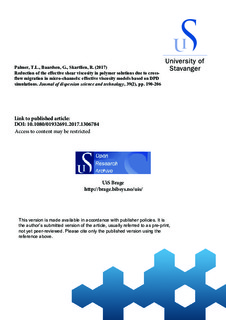Reduction of the effective shear viscosity in polymer solutions due to crossflow migration in microchannels: Effective viscosity models based on DPD simulations
Journal article
Submitted version
Permanent lenke
http://hdl.handle.net/11250/2491214Utgivelsesdato
2017-03Metadata
Vis full innførselSamlinger
Originalversjon
Palmer, T.L., Baardsen, G., Skartlien, R. (2017) Reduction of the effective shear viscosity in polymer solutions due to crossflow migration in micro-channels: effective viscosity models based on DPD simulations. Journal of dispersion science and technology, 39(2), pp. 190-206 10.1080/01932691.2017.1306784Sammendrag
Molecular dynamics simulations (dissipative particle dynamics–DPD) were developed and used to quantify wall-normal migration of polymer chains in microchannel Poseuille flow. Crossflow migration due to viscous interaction with the walls results in lowered polymer concentration near the channel walls. A larger fraction of the total flow volume becomes depleted of polymer when the channel width h decreases into the submicron range, significantly reducing the effective viscosity. The effective viscosity was quantified in terms of channel width and Weissenberg number Wi, for 5% polymer volume fraction in water. Algebraic models for the depletion width δ(Wi, h) and effective viscosity μe(δ/h, Wi) were developed, based on the hydrodynamic theory of Ma and Graham and our simulation results. The depletion width model can be applied to longer polymer chains after a retuning of the polymer persistence length and the corresponding potential/thermal energy ratio.
